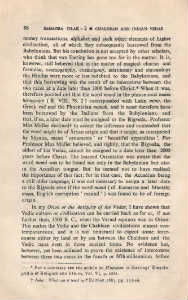Page 734 - Lokmanya Tilak Samagra (khand 2)
P. 734
86 SAMAGRA TILAK - 2 • CHALDEAN AND INDIAN VEDAS
money transactions, alphabet·;and such other elements of higher
civilization, all of which they subsequently borrowed from the
Babylonians. But his conclusion is not accepted by other scholars,
who think that von Ihering has gone too far in the matter. It is,
however, still believed that in Jhe matter of magical charms and
fonnu]re, cosmography, cosmogony, astronomy and chronology
the. Hindus were more or less indebted to the Babylonians, and
tliat thi.:;_ borr~wiijg was the . result of an intercourse between the
two races at a date later than 2000 before Chrict. • When it was;
therefore pointed out that the word mana in· the phrase saca nuvui
hiratJyayp ( ~. Vlll. 78. 2 ) corresponded with Latin mina, the
Greek vua and the Phoenician manah, and it must therefore have
been borrowed by the Indians from the Babylonians, and
that, if so, a later date must be assigned to the ~igveda. Professor
Max Miiller declinedt to accept the inference and contended that
the word might be of Aryan origin and that it might, as interpreted
by Saya~a, mean 'ornaments' or 'beautiful appendices'. For
Professor Max Muller believed; and rightly, that the ~igveda, the
oldest of the Vedas, cannot be as igned to a date later than 2000
years before Christ. The learned Orientalist was aware that the
word mana was to be found not only in the Babylonian but also
in the Accadian tongue. But he seemed not to have realised
the importance of this fact; for in that case, the Accadian being
a still older language, it was not necessary to assign a later date
to the ~igveda even if the word mana ( cf. Kanarese and Maratht
mQtJQ, English corruption 'maund ') was found to be of foreign
origin.
In my Orion or the Antiquity of the Vedas, I have shown that
Vedic culture or civilization can be carried back as far as, if not
further than, 4500 B. C., when the Vernal equinox was in Orion.
This makes the Vedic and the Chaldean civilizations almost con-
temporaneous, and it is not unnatural to expect some inter-
course either by land or by sea between the Chaldean and the
Vedic races even in those ancient times. No evidence has,
however, yet been adduced to prove the existence of intercourse
between these two races in the fourth or fifth millennium before
" For a summary see the article on Hinduism in Hastings' Encyclo-
predia of Religion and Ethics, Vol. VI, p. 688f.
t lutiia: What wn it ttaclz zts! Edition 1883, pp. 125-26.

